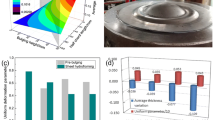Abstract
This paper presents the overlapping sheet hydraulic bulge, which can effectively improve the formability of low plasticity sheet metal by controlling or changing the force conditions and stress states of the target sheet. In the process, the material performance and thickness of the overlapping sheet play an important role in the formability of the target sheet. In this paper, the overlapping sheet hydraulic bulge process is theoretically analyzed. Also, limit bulging tests of no-overlapping sheet, different overlapping sheet materials and different overlapping sheet thicknesses are carried out by taking the aluminum alloy 2B06 as the research object, and the limit bulging heights of specimens are analyzed. Meanwhile, various aspects such as the specimen geometric shape and thickness distribution have been studied to verify the accuracy of the theoretical analysis. Finally, FEM is used to analyze the forming process to explain some results which were found in the test, and the comparison shows good agreement between the numerical results and test data. The results show that the overlapping sheet-forming method is beneficial for the formability attributes of target sheets. Deformation uniformity and the ability of plastic deformation can be improved by choosing higher strength coefficient K, larger work hardening exponent n and proper thickness of the overlapping sheet.


















Similar content being viewed by others
Abbreviations
- P :
-
Hydraulic pressure (MPa)
- P 1 :
-
Reversed pressure in central area of target sheet (MPa)
- P 2 :
-
Reversed pressure in flange area of target sheet (MPa)
- K :
-
Strength coefficient of overlapping sheet (MPa)
- n :
-
Work hardening exponent of overlapping sheet
- t :
-
Overlapping sheet thickness (mm)
- K 1 :
-
Overlapping sheet strength coefficient (MPa)
- n 1 :
-
Overlapping sheet hardening exponent
- K 2 :
-
Target sheet strength coefficient (MPa)
- n 2 :
-
Target sheet hardening exponent
- σ 1 :
-
Stress of overlapping sheet (MPa)
- σ 2 :
-
Stress of target sheet (MPa)
- σ ρ :
-
Radial stress of overlapping sheet (MPa)
- σ θ :
-
Circumferential stress of overlapping sheet (MPa)
- σ ′ ρ :
-
Radial stress of target sheet (MPa)
- σ ′ θ :
-
Circumferential stress of target sheet (MPa)
- σ t :
-
Thickness stress of target sheet (MPa)
References
Chen XY, Zhao LT, Bai CH et al (2008) Analysis of precision sheet metal forming technology in the field of aviation manufacturing application. Aviat Precis Manuf Technol 44(2):38–41
Hou HL, Yu XF, Zeng YS (2009) Current and development status of sheet metal equipment and technology in Chinese aviation industry. Aeronaut Manuf Technol 1:34–39
Gao TJ, Wang Y, Liu JG, Wang ZJ (2013) Research on formability of aluminum alloy 2024 Sheet by viscous pressure forming. Adv Mater Res 634:2872–2876
Swink M (1999) Threats to new product manufacturability and the effects of development team integration processes. J Oper Manag 17(3):691–709
Liu YH, Wang G, Wang RJ et al (2007) Super plastic bulk metallic glasses at room temperature. Science 315:1385–1388
Wang Z, Wang ZJ (2009) Effect of backpressure on the formability of sheet metal during viscous pressure bulging. Mater Sci Technol 17(6):875–878
Chen FK, Chiu KH (2005) Stamping formability of pure titanium sheets. J Mater Process Technol 170(1–2):181–186
Liu BS, Lang LH, Li HL et al (2011) Review on methods of constitutive modeling in warm/hot hydroforming. J Plast Eng 18(3):53–59
Lang LH, Wang SH, Yuan C (2014) Research on the innovative hybrid impact hydroforming punching. J Plast Eng 21(2):51–54
Ma AP, Rao GN, Peng JH, Tang WL (2013) Experimental research on explosion forming process of elliptical head. Explos Mater 42(1):43–46
Yu HP, Li CF (2007) Effects of coil length on tube compression in electromagnetic forming. Trans Nonferrous Met Soc China 17:1270–1275
Smith LM, Averill RC, Lucas JP et al (2003) Influence of transverse normal stress on sheet metal formability. Int J Plast 19(10):1567–1583
Nurcheshmeh M, Green DE (2012) Influence of out-of-plane compression stress on limit strains in sheet metals. Int J Mater Form 5(3):213–226
Wang ZJ, Wang Z, Li MX (2007) Failure analysis of Al1060 sheets under double-sided pressure deformation conditions. Key Eng Mater 353–358:603–606
Amino H, Nakamura K, Nakagawa T (1990) Counter-press deep drawing and its application in the forming of automobile parts. J Mater Process Technol 23:243–265
Masanori K, Nobukazu H, Yasushi K (2001) Improvement of pure stretch ability by overlapping sheet metals. J Jpn Soc Technol Plast 42(43):328–332
Masashi H, Kazuyoshi K (1985) Press forming of clad sheets. J Mater Process Technol 26(291):385–393
Tao YR (2009) Experimental study and numerical simulation of the drawing of hemisphere-shaped FVS0812 Part. Mech Sci Technol Aerosp Eng 28(6):814–818
Semiatin SL, Piehler HR (1979) Forming limits of sandwich sheet materials. Metall Trans A 10:1107–1118
Tseng HC, Hung CH, Huang CC (2010) An analysis of the formability of aluminum/copper clad metals with different thicknesses by the finite element method and experiment. Int J Adv Manuf Technol 49:1029–1036
Acknowledgments
The authors gratefully acknowledge the financial support from National Science and Technology Major Project with Grant No. 2014ZX04002041 and National Science Foundation of China with Grant No. 51175024. Meanwhile, Associate Professor Tiejun Gao of Shenyang Aerospace University, definitely gains our deepest gratitude for his contribution to this course.
Author information
Authors and Affiliations
Corresponding author
Additional information
Technical Editor: Alexandre Mendes Abrao.
Rights and permissions
About this article
Cite this article
Wang, Y., Lang, L., Zafar, R. et al. Investigation into the overlapping sheet hydraulic bulge and its formability. J Braz. Soc. Mech. Sci. Eng. 38, 1635–1645 (2016). https://doi.org/10.1007/s40430-015-0430-5
Received:
Accepted:
Published:
Issue Date:
DOI: https://doi.org/10.1007/s40430-015-0430-5




